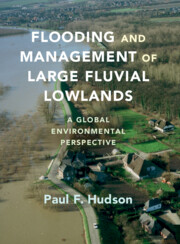Book contents
- Flooding and Management of Large Fluvial Lowlands
- Flooding and Management of Large Fluvial Lowlands
- Copyright page
- Dedication
- Contents
- Figures
- Tables
- Preface and Acknowledgments
- 1 Fluvial Lowlands and the Environment
- 2 Rivers and Landscapes
- 3 Hydrologic and Geomorphic Processes in Fluvial Lowlands and Deltas
- 4 Dams, Rivers, and the Environment
- 5 Hydraulic Engineering for Channel Stability and Flood Control
- 6 Dikes and Floodplains
- 7 Flood Basins and Deltas
- 8 Toward Integrated Management of Lowland Rivers
- 9 Lessons Learned
- Bibliography
- Index
3 - Hydrologic and Geomorphic Processes in Fluvial Lowlands and Deltas
Published online by Cambridge University Press: 04 November 2021
- Flooding and Management of Large Fluvial Lowlands
- Flooding and Management of Large Fluvial Lowlands
- Copyright page
- Dedication
- Contents
- Figures
- Tables
- Preface and Acknowledgments
- 1 Fluvial Lowlands and the Environment
- 2 Rivers and Landscapes
- 3 Hydrologic and Geomorphic Processes in Fluvial Lowlands and Deltas
- 4 Dams, Rivers, and the Environment
- 5 Hydraulic Engineering for Channel Stability and Flood Control
- 6 Dikes and Floodplains
- 7 Flood Basins and Deltas
- 8 Toward Integrated Management of Lowland Rivers
- 9 Lessons Learned
- Bibliography
- Index
Summary
Flooding of large lowland rivers is dependent upon seasonal variability in Earth’s general circulation, in addition to large-scale atmospheric teleconnections. Large lowland rivers are unique in that local-scale hydrologic and geomorphic controls also influence floodplain inundation, creating challenges to government management organizations. River bank erosion is a key geomorphic process linked to seasonal discharge pulses, as well as channel bank sedimentology. Flood sedimentary processes are influenced by older floodplain geomorphology atop negative relief floodplains that provides a topographic framework for sediment dispersal. River deltas form downstream of fluvial hinge-lines, with the apex at the main channel avulsion node. At the terminus of drainage basins, the geometry of deltaic sedimentary deposits is influenced by the dominance of either fluvial, tidal, or wave processes. Fluvial dominated deltas are characterized within the ‘delta cycle,’ a conceptual model that provides important insights to the development of sediment management strategies to address coastal land loss caused by sea level rise, subsidence, and reduced sediment flux because of upstream dams.
Keywords
- Type
- Chapter
- Information
- Flooding and Management of Large Fluvial LowlandsA Global Environmental Perspective, pp. 31 - 79Publisher: Cambridge University PressPrint publication year: 2021

